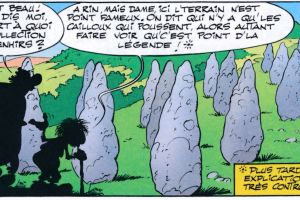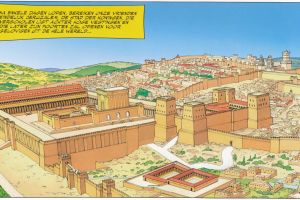Exegi Monumentum Aere Perennius
In Asterix and the Banquet (Le Tour de Gaule d’Astérix), a Roman soldier is seen building a wooden palisade around the indomitable Gaulish village. While doing so, he remarks: “Exegi monumentum aere perennius.” This Latin phrase is a direct quotation from classical Roman poetry, and it stands in stark contrast to the temporary nature of the structure the Roman is constructing.

Literary Origin
The phrase originates from the Roman poet Horace (Quintus Horatius Flaccus), one of the most influential literary figures of the Augustan Age. It appears in the first line of Odes Book III, Poem 30, written around 23 BCE:
Exēgī monumentum aere perennius
“I have completed a monument more lasting than bronze.”
In this context, Horace refers not to a physical monument, but to his own poetry, which he believed would outlast any material construction and grant him a form of literary immortality.

Literal Translation and Grammatical Explanation
The Latin sentence can be translated as:
“I have completed a monument more lasting than bronze.”
Word-by-word breakdown:
- Exēgī – First person singular, perfect tense of exigere, meaning “I have completed” or “I have brought to a close.”
- Monumentum – Neuter accusative singular noun meaning “monument” or “memorial.” In Roman usage, this could refer to a building, statue, or even a written work.
- Aere – Ablative singular of aes, meaning “bronze.” The ablative case is used with comparatives to express the thing being compared.
- Perennius – Comparative adjective of perennis, meaning “more lasting” or “more enduring.”
The structure follows a common Latin poetic style, with a compact and elevated expression.
Historical Use
Horace used the line to declare that his poetry would survive the ravages of time better than any statue or bronze structure. This belief in the enduring power of words over physical monuments was a common theme in Roman literature and became especially prominent during the Augustan era, when poets were consciously shaping Rome’s cultural legacy.
Modern Recognition
Over the centuries, Exegi monumentum aere perennius has become one of the best-known Latin quotations. It has been cited in literary and academic texts and used to signify the lasting influence of artistic or intellectual achievements. The phrase often appears in memorials, school mottos, and works discussing the permanence of culture.
Use in Asterix and the Banquet
In the story, the Roman soldier uses the phrase while constructing a wooden wall—a palisade—intended to trap the Gauls inside their village and prevent them from completing their tour of Gaul. The quote is used ironically: while Horace’s original “monument” referred to enduring literary achievement, the wall being built in the comic is of course short-lived barrier.
Conclusion
Exegi monumentum aere perennius is a phrase loaded with historical and literary significance. Penned by Horace to celebrate the durability of his poetic legacy, it appears in Asterix and the Banquet in a comic setting where a Roman builds a wooden palisade that is anything but permanent. For Latin learners and classical enthusiasts, this moment highlights the educational depth and clever allusions embedded in the Asterix series.





Leave a comment (keep it civilised)